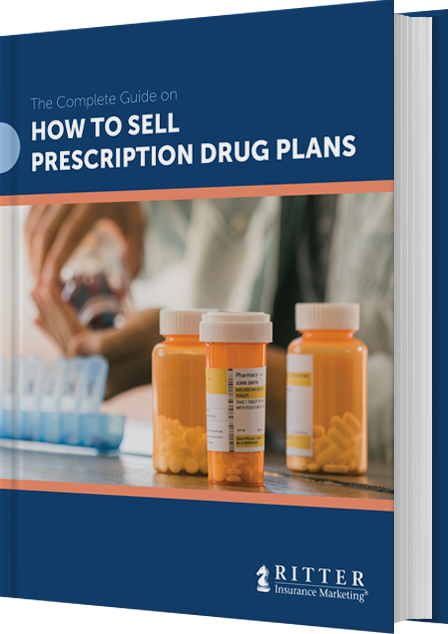With almost 90 percent of older adults taking at least one prescription medication and slightly more than 50 percent taking four or more, Part D prescription drug plans (PDPs) are an undeniably important component of comprehensive coverage. But some need drug plans more than others.
Listen to this article:
Ideal PDP prospects dwell either in plans that don’t offer drug coverage or in plans that don’t meet their needs. We’re here to teach you how to easily spot these clients.
Who Is Eligible for Medicare Part D?
Anyone aged 65 or older who is eligible for Medicare Part A is also eligible for Medicare Part D. This means that your client does not necessarily need to be a U.S. citizen, just a lawful permanent resident who’s worked the necessary amount of time, usually about 10 years. Anyone enrolled in a Medicare Advantage plan with prescription drug coverage (MAPD) is not eligible to enroll in a stand-alone Part D drug plan.
Although older adults are not required by law to enroll in a prescription drug plan when they turn 65, they’ll incur late-enrollment penalties if they postpone enrolling past 65 and do not have creditable drug coverage. Creditable drug coverage, for example, could come from an employer health plan if your client is still working and has delayed signing up for Part B. Health carriers annually release whether the drug coverage they offer in group plans is considered creditable by Medicare. If clients don’t have creditable drug coverage from another plan, then they will need to enroll in Part D if they wish to avoid penalties.
Although older adults are not required by law to enroll in a prescription drug plan when they turn 65, they’ll incur late-enrollment penalties if they postpone enrolling past 65 and do not have creditable drug coverage.
The Ideal PDP Client
Who is ideal goes a step further than who is eligible. Use these categories to guide your drug plan sales.
The Original Medicare Enrollee
Those only enrolled in Part A and B have limited drug coverage and would benefit from a Part D plan. Medicare Supplements, while covering gaps in Part A and B coverage, are not allowed to cover prescription drugs if sold after January 1, 2006. Selling drug plans alongside Med Supps ensures your clients receive sufficient coverage.
Selling drug plans alongside Med Supps ensures your clients receive sufficient coverage.
The 11 Percent
While [89 percent](https://www.kff.org/medicare/press-release/a-record-3834-medicare-advantage-plans-will-be-available-in-2022-up-8-percent-from-2021-while-the-number-of-medicare-part-d-stand-alone-plans-is-decreasing-mainly-due-to-firm-consolidations/#:~:text=Most%20Medicare%20Advantage%20plans%20(89,Medicare’s%20standard%20Part%20B%20premium. “A Record 3,834 Medicare Advantage Plans Will be Available in 2022, Up 8 Percent From 2021, While the Number of Medicare Part D Stand-Alone Plans is Decreasing Mainly Due to Firm Consolidations”) of Medicare Advantage (MA) plans cover prescription drugs, the remaining 11 percent of plans do not, including Medicare Medical Savings Accounts (MSA) and some Private Fee-for-Service (PFFS) plans. If you enroll any clients in a type of MA plan that doesn’t have drug coverage, make sure you go over their drug plan options.
The Cost Plan Enrollee
A small number (only 186,127) of Medicare beneficiaries are enrolled in a Medicare Cost plan. Instead of replacing your coverage through original Medicare with a new type of plan, like Part C does, Medicare Cost plans provide extra benefits in addition to Parts A and B. Private insurance companies sell these plans, similarly to MA plans. Some Medicare Cost plans come bundled with optional Part D drug coverage while others do not. If you sell Medicare Cost plans, make sure your client knows what their drug coverage and options look like.
The Dissatisfied & Not Well-Informed
Many Part D beneficiaries are unhappy with their plans or not well-informed about their options. According to KFF:
- About half (45%) of older adults with a drug plan experienced an issue with their current plan in the last year.
- Only 20% of older adults used a discount when getting a prescription filled.
- About half (47%) of older adults report comparison shopping when they chose their current plan.
Many Part D enrollees are having problems, spending too much for prescriptions, and enrolling in plans that may not suit their specific drug needs. They may not know the benefit of reviewing drug plans with a skilled insurance agent during AEP since their prescriptions and drug formularies may have changed.
Many Part D enrollees are having problems, spending too much for prescriptions, and enrolling in plans that may not suit their specific drug needs.
There’s huge potential to grow your business when you help the dissatisfied and less knowledgeable get into better-fitting plans. Make sure you’re asking current and potential clients for updates in prescriptions and for their level of satisfaction with their drug plans. It might be time for a change.
Original Medicare + PDPs vs. MAPDs
The bundling of prescription drug coverage with coverage for hospital and doctor office visits appeals to many people because of lower premiums and plan simplicity; however, Part C might not always be the best option for a client. Many factors, including needing brand-name drugs instead of generic, extended-release formulations instead of immediate release, and maintenance drugs taken at home instead of administered at the doctor, can all play into whether an MAPD in your area is the best fit for your client. Look closely at your client’s prescriptions and compare them to the formulary for the in-question MAPD plan to see if that lower premium will really mean lower monthly costs like your client wants.
It may come down to your client’s location. MAPDs are not offered in every county and may not be available in more rural areas. For some of your clients, an MAPD may not even be an option!
Finding Your Cinderella
Identifying your next PDP client can be like hunting down Cinderella with 10 glass slippers in tow. You find her and start trying on slippers. If you’re the prince in this metaphor, then let us be your footman, handing you slippers and helping you determine whether the slipper is too tight, too loose, or just right. We make the hunt for the best fitting slipper easy with Shop & Enroll, our platform for supplying PDP quotes, collecting eScopes, sending prefilled applications, and enrolling clients. Sign up for your free site today!
Whether your ideal PDP client is new to Medicare or just in need of an annual drug review, you have a partner in a field marketing organization (FMO) like Ritter Insurance Marketing. We have tools, resources, and lead programs that will aid you in your search for Cinderella and her glass slipper.
Need more help? We’ve compiled all the information you need to know about selling PDPs in our free eBook, The Complete Guide on How to Sell Prescription Drug Plans. Request your free copy!

PDPs are simple when you register with Ritter for free and gain access to Shop & Enroll, your one-stop shop for collecting eScopes, sending prefilled applications, and enrolling clients!






Share Post